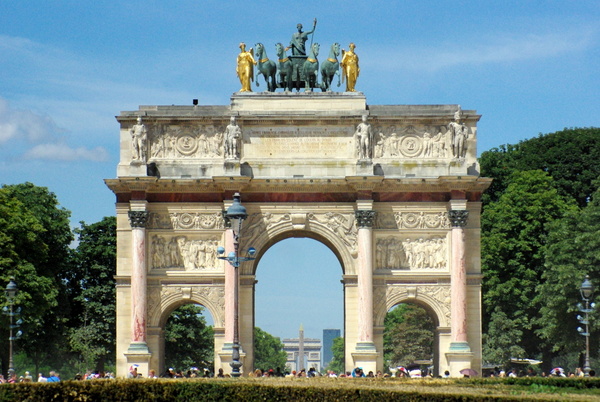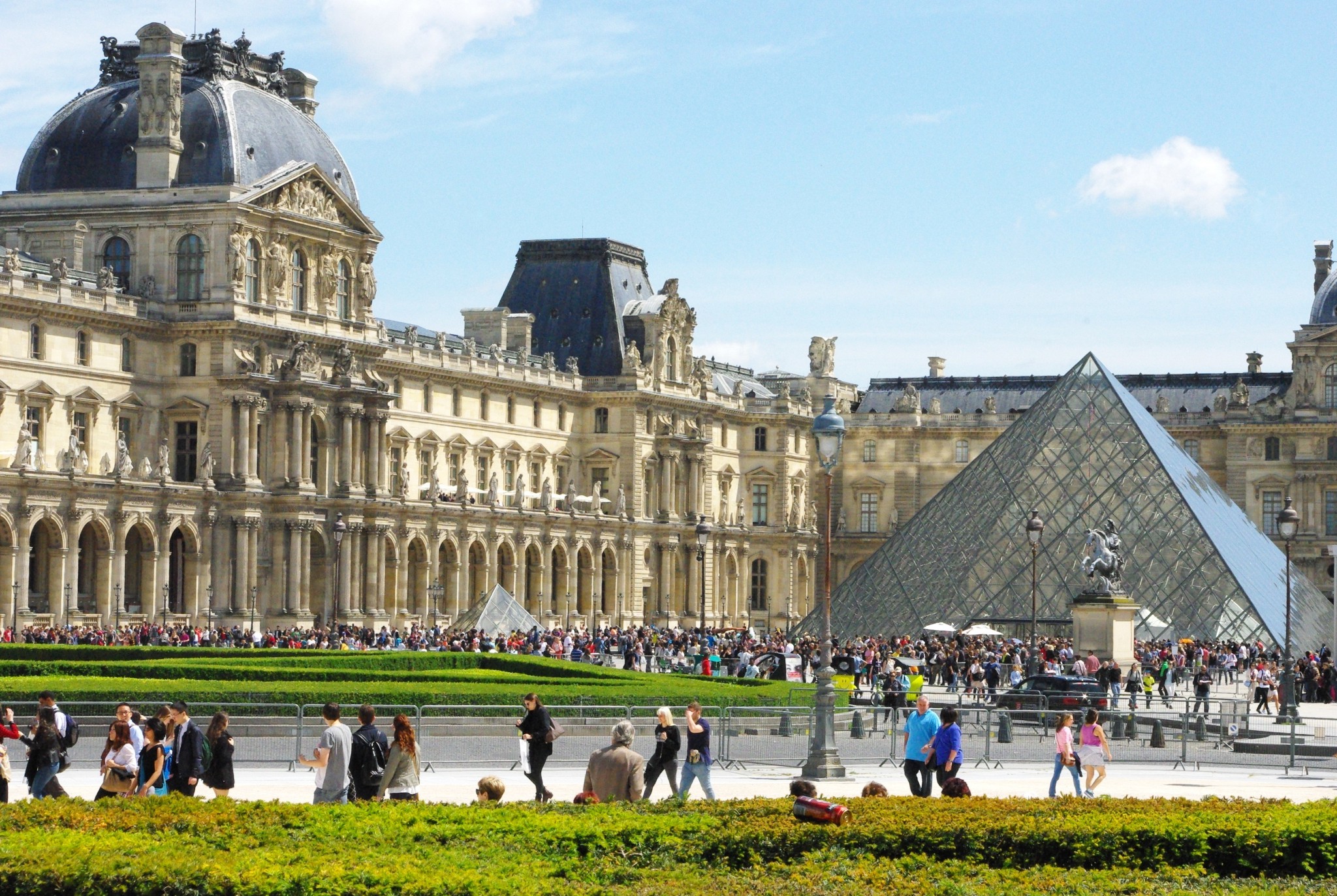The Louvre Palace is “royal Paris”. A part of the French capital that no visitor should miss. Palace of the Kings and Queens of France, the Louvre has now become one of the world’s most visited museums. The Louvre and the Tuileries are the starting points of the grand Historical Axis. This magnificent vista runs through some of Paris’ most celebrated monuments and squares: the Glass Pyramid of the Louvre in the Cour Napoléon, the Arc du Carrousel, the former Palace of the Tuileries destroyed in the 19th Century and the gardens of the Tuileries. Beyond, the axis crosses the majestic Place de la Concorde and its Egyptian obelisk. Then it runs through the Champs-Elysées, dominated by the famous Arc de Triomphe.
The Louvre Palace

The Louvre is located in the First Arrondissement. It is the starting point of the Historical Axis (Voie Triomphale).
The great perspective starts at the Louvre, immediately beyond the Church of St Germain l’Auxerrois. The crab-shaped Palace was the main residence of the kings of France until 1682. That year Louis XIV, the ‘Sun King’, moved his court to Versailles.
The palace currently houses one of the world’s most wonderful museums in a complex that is known as the “Grand Louvre”.

The medieval Louvre
The medieval castle which no longer exists today was built by King Philip Augustus in the 12th Century. Its foundations (including the keep, two towers and the support of the drawbridge) were excavated during the 1980s restoration. They can be seen at the basement level.

During the Renaissance era
In 1546, King Francis I (François 1er) decided to dismantle the medieval fortress. He envisioned replacing it with a larger and more fashionable structure based on the Renaissance. The Cour Carrée is one of the finest examples of Renaissance architecture in France.

The ‘Grand Dessein’
Napoleon and Napoleon III worked on achieving the ‘Grand Dessein’ (Great Design) which King Henry IV (16th C) had in mind. The plan was to join the Louvre to the Tuileries Palace by a series of wings. The new complex was then a formidable array of buildings. It was the largest in Europe, as the Tuileries Palace closed off the western end of the Louvre courtyard.

The Sully Pavillon:

The ‘Grand Louvre’
As for President François Mitterand, he left his mark with his “Grand Louvre”. The pharaonic project had to be completed in time for the bicentennial celebration of the French Revolution in 1989. This comprised major renovation works (clearing the façade, transforming the interior, and constructing underground hallways and a commercial centre). Not forgetting moving the Finance Ministry to a new modern building in Bercy. Finally, the “Grand Louvre” included the construction of a new landmark along the Historical Axis: the celebrated Glass Pyramid.
Today the Louvre Museum welcome 30,000 visitors each day. The museum displays more than 35,000 masterpieces and artefacts across 400 rooms.

The Glass Pyramid of the Louvre
Some like it, others hate it… the imposing but controversial Glass Pyramid commissioned by Mitterand from Ieoh Ming Pei has played a major role in the “Grand Louvre” in serving as its principal entrance since 1988. With a height of 20 metres and its some 670 glass segments, the transparent monument echoes the Obelisk that rears up towards the sky in Place de la Concorde. It is not a surprise to find an Egyptian theme, dear to Mitterrand, in Paris. Besides, Ieoh Ming Pei may have come across similar design projects that had been proposed without success in the past. In fact, a baroque pyramid was indeed put forward to be built in the Cour Napoléon for the centennial celebrations of the Revolution.
The symbolism behind the Egyptian pyramid lies in the cult of the Supreme Being (“Etre Suprême”) which can be seen in the frontispiece of the 1789 Declaration of Human Rights. This Masonic symbol (the ‘Eye in the Pyramid’) was also used in America. But even before the French Revolution, a pyramid to the glory of the Sun King was also proposed for the Cour Carrée by a French architect.
The Inverted pyramid
Further to the West lies another glass structure, the Inverted Pyramid (“Pyramide Inversée”) only visible from the underground “Galerie Carrousel du Louvre”. It brings a well of light to the centre of the visitor complex.
The Equestrian statue of Louis XIV

In Cour Napoléon, the Historical Axis does not run through the Glass Pyramid and the centreline of the courtyard. This led architect Pei to request that a particular statue of Louis XIV be placed adjacent to the Pyramid and in the direct path of the Historical axis. The equestrian statue made in bronze portrays the Sun King as ‘Alexander the Great’. It is a later copy of the original statue executed by Bernini in 1668 in marble displayed at Versailles.

As for today, the Historical Axis leads through the Cour Napoléon to strike the Sully Pavilion, thus deviating from the centre line of the courtyard, where the Glass Pyramid now stands. From the second window of the Sully façade, the view along the great perspective all the way to the Grande Arche of La Défense is spectacular. Only a few Paris insiders will know of it!
The Arc de Triomphe du Carrousel

The second monument aligned with the Historical Axis is the Arc du Carrousel. Napoleon built the triumphal arch from 1807 to 1808 to celebrate the victory of the French imperial army in Austerlitz. The Arc du Carrousel was designed by Charles Percier and Pierre-François-Léonard Fontaine on the model of the Arch of Septimius Severus and the Arch of Constantine in Rome.
Find out more about the Arc de Triomphe du Carrousel.
More info about the Louvre
- Location: on the Right Bank on the 1st arrondissement… you can’t miss it at the palace is situated in the very centre of Paris!
- Closest métro stations: Palais Royal – Musée du Louvre (métro lines 1 and 7) or Louvre Rivoli (métro line 1)
- Visit the official website of the Louvre museum.
- If you’re heading to Paris and want to visit the Louvre museum, I’ve got some great news you might be interested in.
- It’s such a shame when you are on holiday and lose precious time queuing for museums and monuments.
- Our partner Tiqets give their users fast-track access to the Louvre.
- The E-Ticket they sell not only gives you fast-track access but also direct access (no need to exchange a voucher for a ticket) and entrance via the Pyramid, using the line for E-Ticket holders.
- The E-Ticket gives you access to afternoon time slots only.
- Admission must be within 30 min of the start of the allocated time slot.
- Get your fast-track Tickets to the museum NOW!
Did you find what you read interesting? If so, please do share this article on Facebook or Twitter!





